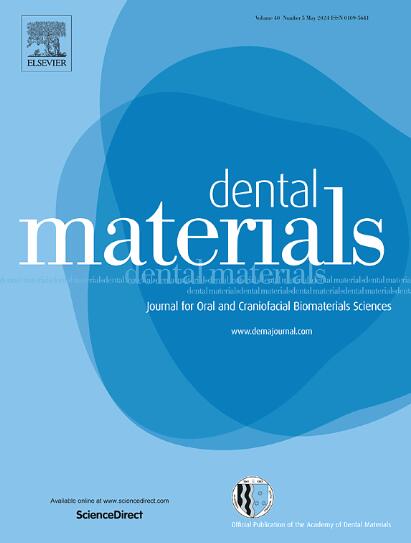Long-lasting antimicrobial effect of multipurpose ZnO nanoparticle-loaded dental resins enhanced by blue light photodynamic therapy
IF 4.6
1区 医学
Q1 DENTISTRY, ORAL SURGERY & MEDICINE
引用次数: 0
Abstract
Objectives
This study aimed to assess the potential of experimental dental resins containing ZnO nanoparticles (ZnO-NPs) for antimicrobial photodynamic therapy (aPDT) as a functional tool for the modulation of cariogenic biofilm in long-term.
Methods
Minimum inhibitory and bactericidal concentrations (MIC/MBC) of ZnO-NPs against Streptococcus mutans were initially determined under different energy densities of blue LED irradiation (0.00, 1.35, 6.75, or 20.25 J/cm2) to optimize aPDT parameters. Experimental dental resins were then formulated with 0 % (control), 5 %, 10 %, and 20 % ZnO-NPs. Resin disks (1 mm x 6 mm) were prepared to evaluate the antimicrobial and photocatalytic potential of the experimental groups associated with 0 (dark), 1, 2, or 4 light cycles of blue-light irradiation (20.25 J/cm2, each cycle). The CFU count and Live/Dead assays were performed on a cariogenic biofilm model (S. mutans) on fresh and 6-month aged resin disks.
Results
Blue light at 20.25 J/cm2 decreased MIC (from 250 µg/mL to 125 µg/mL) and MBC (from 1000 µg/mL to 500 µg/mL), establishing the optimal aPDT protocol. Experimental resins with 5 %, 10 %, or 20 % ZnO-NPs, when exposed to 4 cycles of blue light, significantly reduced biofilm viability compared to controls, both initially and after aging. The 20 % ZnO-NP resin sustained > 3.log10 CFU reduction after 6 months, even with 2 cycles of light. Live/Dead assays showed > 50 % dead cells with the 20 % ZnO-NP resin after 2 light cycles.
Significance
ZnO-NP-loaded dental resins associated with blue light aPDT offer promise as a long-lasting antimicrobial alternative, potentially enhancing the control of pathogenic biofilms.
求助全文
约1分钟内获得全文
求助全文
来源期刊

Dental Materials
工程技术-材料科学:生物材料
CiteScore
9.80
自引率
10.00%
发文量
290
审稿时长
67 days
期刊介绍:
Dental Materials publishes original research, review articles, and short communications.
Academy of Dental Materials members click here to register for free access to Dental Materials online.
The principal aim of Dental Materials is to promote rapid communication of scientific information between academia, industry, and the dental practitioner. Original Manuscripts on clinical and laboratory research of basic and applied character which focus on the properties or performance of dental materials or the reaction of host tissues to materials are given priority publication. Other acceptable topics include application technology in clinical dentistry and dental laboratory technology.
Comprehensive reviews and editorial commentaries on pertinent subjects will be considered.
 求助内容:
求助内容: 应助结果提醒方式:
应助结果提醒方式:


